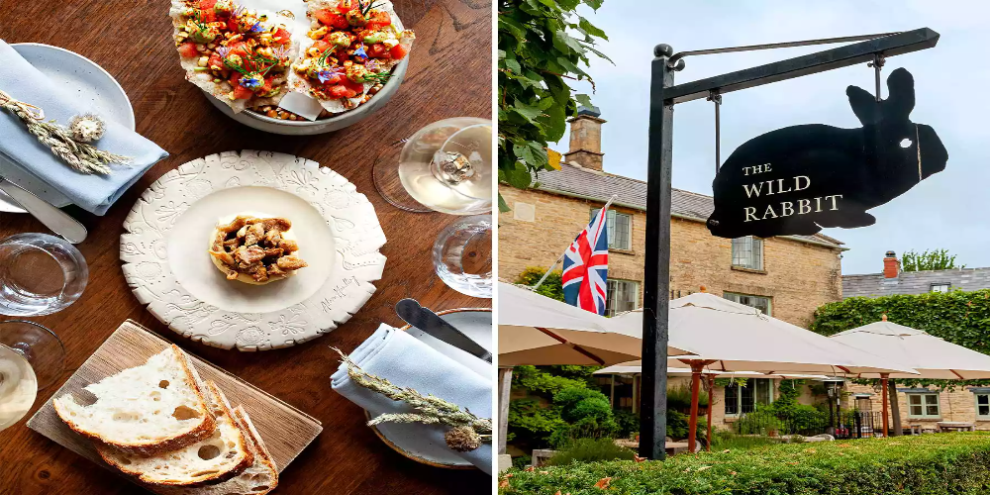Although it is a hot summer’s day—80 degrees, warm for London, even in July—the handsome wood-paneled dining room of the Bull & Last (doubles from $180; entrées $33–$48) is at full socially-distanced capacity. The pub’s Sunday roast is consistently voted one of the best in London, and weekends are booked out with neighborhood families, diners from further afield, and even the odd celebrity (writer Julian Barnes and actors Damian Lewis and Juliet Stevenson are all regulars). Everyone seems to be drinking pints of pale ale and ordering ordering North Essex shorthorn sirloin or prime rib accompanied by airy puffs of Yorkshire pudding.
The pub, situated opposite the wild expanses of Hampstead Heath, has been one of north London’s prime culinary destinations ever since co-owners Joe Swiers and Ollie Pudney—who’s also the chef—got the keys in 2008. But, like most things in this city, the Bull & Last’s history goes back much further: it was first mentioned in court records in 1721, and would at the time have been a coaching inn on the road to central London—a place for coachmen and their passengers to spend the night before setting off on the last leg of their journey.
Central London may no longer be a horse-drawn-coach journey away, but this corner of the city was nonetheless in need of stylish accommodations. The first floor of the pub, a high-ceilinged dining room presided over by a mounted stag’s head, does a roaring trade in weddings and parties; Swiers and Pudney told me they had often struggled to recommend a decent place for guests to stay nearby.
:max_bytes(150000):strip_icc():format(webp)/wild-rabbit-dining-room-BRITISHPUBS1021-1735678f60e1478d846023fdee4f8355.jpg)
I knew just what he meant: my husband, Nic, and I had our wedding reception there, and had similar issues trying to house relatives in Hampstead’s few hotels. The decision to add six luxurious bedrooms to the upper floors, restoring the Bull & Last to its original incarnation as an inn, is something of a departure for a London pub. But even before the accommodations opened in 2021, the booking inquiries came flooding in.
In keeping with the area’s rich cultural history, each of the rooms is themed around an eminent local figure. Nic and I stayed in a large space in the eaves of the Georgian building that was named after Michael Faraday, the 19th-century pioneer of electromagnetism. (A freestanding copper bathtub and copper bedside lamps nod to his legacy.)
After a dinner of tuna tartare with mango and sesame and a sampler of superb desserts, we retired to our quarters to make use of the elegant cocktail kit—brass shaker and gold strainer, proper crystal glasses—left out for guests wanting to carry on the party after “last orders,” as it’s known here. In the mini-bar, a ready-mixed selection of Bull & Last cocktails and an unwaxed lemon awaited.
I have celebrated birthdays—more than I can count—in my local, as one’s regular pub is known. I’ve met with work colleagues, cheered up distraught friends over bottles of wine, broken up with boyfriends, been on first dates. These are the places where British lives play out. There will always be a need for that.
Adding rooms is a smart innovation at a time when England’s pubs, however established, are in urgent need of reinvention. Over the past few years, challenges to the industry have been myriad. As habits change and Brits increasingly shun a night of pints and packets of crisps in favor of a bottle of wine at home, many “wet pubs”—those that serve only drinks—have closed their doors.
Ever since the Eagle, in the Farringdon neighborhood of northeast London, kicked off the “gastropub” movement in the early 1990s by serving elevated food in a laid-back setting, any pub worth its salt must have a decent chef and a chalkboard menu. But serving fresh food means far higher costs—something many pubs were struggling with even before COVID-19. The U.K. lockdowns shuttered all hospitality for months and many pubs, sadly, did not reopen.
:max_bytes(150000):strip_icc():format(webp)/hand-and-flowers-bar-star-dish-BRITISHPUBS1021-e7057ce1a6d74973b84f64f53c636d75.jpg)
But it will take more than a pandemic to wipe out such a deeply ingrained part of British culture. The pub is as quintessential to the U.K. as the café is to France, the taverna is to Greece, or the trattoria is to Italy. The artist William Blake once compared the importance of the pub to that of the church, “except that a pub is warmer, and there’s more conversation.”
Over the years, as well as having my wedding reception in a pub, I have celebrated birthdays—more than I can count—in my local, as one’s regular pub is known. I’ve met with work colleagues, cheered up distraught friends over bottles of wine, broken up with boyfriends, been on first dates. These are the places where British lives play out. There will always be a need for that.
And, thanks to a handful of passionate, creative proprietors, chefs, and hoteliers, who have brought their energy and vision to reinvigorate establishments across the country, there are green shoots of optimism. Over the summer, my family and I set out to explore these groundbreaking places, to see how their owners are changing our ideas about what a pub can be.
:max_bytes(150000):strip_icc():format(webp)/bull-and-last-owneres-BRITISHPUBS1021-f6af6f6ac7b0454ca52958e8e78b3266.jpg)
Having an international following and a bunch of successful restaurants isn’t a necessity when it comes to opening a new pub, but it certainly helps. Adam Handling is the Scottish chef-owner of three restaurants, including Frog, in Covent Garden, and Ugly Butterfly, in Cornwall. Handling’s trademark is luxurious dining with zero waste, and in 2021, he added a new sustainable pub hotel to his flock: the Loch & the Tyne (doubles from $177; entrées $22–$54), in Old Windsor.
Post-lockdown was a challenging moment to open, Handling admitted when we spoke ahead of my visit. “It’s massively high-risk. Pubs have lost eighty million pounds in 2021 so far,” he said in his distinctive Scottish burr.
The Loch & the Tyne is on a quiet road overlooking the fields of the Berkshire countryside, just a 10-minute drive from Windsor Castle and all the Union Jacks and tearooms of the town center. Its wooden façade, painted a deep forest green, has an open porch for outdoor dining that feels more South Carolina than southeast England. Handling’s vision for reinventing what was once a tired old boozer?
“I wanted it to be brighter and fresher than a normal corner pub, with a restaurant feel. But somewhere you can still rock up at any time of day, sit by the fire, and sink a hand-poured ale, or have a glass of Krug.”
:max_bytes(150000):strip_icc():format(webp)/fish-and-chips-BRITISHPUBS1021-7ab47e3e3bfa47ddbe5697b024a3c747.jpg)
I remembered his description as we entered the light, spacious dining area with its tartan upholstery—a nod to Handling’s Dundee roots. We were allocated Loch, one of the pub’s two spacious upstairs bedrooms. It was generously stocked with Handling’s own sustainable products, as well as—much to our children’s delight—a jar of homemade shortbread. There was even a little terrace, which we discovered was the perfect place for a sunset aperitif with a view of the aircraft coming in and out of nearby Heathrow. Handy, I thought, for those flying in from afar. The chef’s primary concern, however, is to bring in the locals. “We want to be the favorite in the area, not necessarily the best in the world.”

Judging from the buzz in the restaurant just two weeks after the Loch & the Tyne’s soft opening, Handling has already managed to net a pretty good mix of clients. It was again an unusually warm day, and the pub staff were whizzing round delivering chilled bottles of Handling’s own sparkling wine.
The menu featured pub classics with a twist—a superlative haggis Scotch egg, for instance, and an unctuous burger made with beef and lardo. There were fancier options, too, notably a spectacular barbecued lobster cured in Wagyu beef fat. Handling has plans to expand the kitchen garden. “I want it to be a sort of Soho Farmhouse,” he said, referring to the rustic-chic Cotswolds outpost of the Soho House chain. “With piglets.”
:max_bytes(150000):strip_icc():format(webp)/star-pub-boot-room-BRITISHPUBS1021-1ba276a7673145a988d1a7af63340811.jpg)
Ten miles or so down the road from Windsor, in the picturesque village of Marlow, you’ll find the Hand & Flowers (doubles from $290; entrées $80–$100), the first U.K. pub to offer a true fine-dining experience. Chef Tom Kerridge and his wife, Beth, took over in 2005, and since then the place has been awarded two Michelin stars—the only pub in Britain to receive this accolade. With its low ceilings, exposed beams, and cottagey exterior, it certainly looked and felt like a pub, though the menu and wine list told a slightly different story.
Now with 15 rooms, the Hand & Flowers is very much a destination pub. It requires perseverance to get a table, and so we felt lucky to be squeezed in at the bar for lunch, with a front-row view of the bar staff’s quiet choreography, mixing up Spritzes and pouring glass after glass of English sparkling wine.
The menu, freshly printed that day on weighty paper and sealed in wax, offers a reasonable $55 three-course set lunch; it’s when you go off-piste that things start to get interesting—an $85 fish-and-chips, a sirloin of 30-day dry-aged Dovecote Park beef for an eye-watering $100. All were excellent and, honestly, worth the splurge. Unsurprisingly, the crowd skews very well-heeled. Many groups were clearly observing milestone birthdays or anniversaries; all reverently praised the food to the waitstaff.
:max_bytes(150000):strip_icc():format(webp)/bull-and-last-tom-kerridge-BRITISHPUBS1021-91b4b25c0cab420e85dfce3453f38ad5.jpg)
From the upscale ambience at the Hand & Flowers, you wouldn’t necessarily picture Kerridge, an intensely hardworking and much-loved TV chef and author of several best-selling cookbooks, as a down-to-earth sort of bloke with strong thoughts about the importance of supporting the local pub. But in recent years, he has emerged as something of a champion of the movement to preserve these places, having founded a festival called Pub in the Park, at which chefs from award-winning “boozers” serve food at pop-up events around the U.K.
The social aspect is something Kerridge is clearly passionate about. “Not all pubs are in the middle of the countryside with roaring fires. They are the spaces where people who live in flats or condensed areas get to meet up. It is somewhere to go to escape your home, to mix, to meet, to communicate, to have some sort of social fabric.”
This, he points out, has proven more important than ever over the past 18 months.
:max_bytes(150000):strip_icc():format(webp)/birling-gap-beach-BRITISHPUBS1021-a02f5cc925a74efab74576f3b92642cd.jpg)
But pubs, Kerridge explains, are having to diversify and keep up with the times, just like everyone else. (Aside from the Hand & Flowers, he has five other restaurants, including a fish-and-chips spot in London; another Michelin-starred pub; and the Butcher’s Tap & Grill, a butcher shop by day, a pub by night—the latter two also in Marlow.) Today, it’s just as important to have good Wi-Fi and coffee as it is to have ale on tap. “You have to tick a lot of boxes now,” he added. “It’s not just about lager.”
One place ticking a lot of boxes, and serving excellent coffee, is the Wild Rabbit (doubles from $210; entrées $23–$42), a stone pub hotel in Kingham, in the Cotswolds—once voted by Country Life magazine as “England’s Favourite Village.” The Wild Rabbit is just one part of Carole Bamford’s cultish Cotswolds emporium, Daylesford, situated in and around Kingham and comprising Daylesford Farm, farm shop, Bamford Wellness Spa, and more besides. Bamford, a businesswoman and baroness, took over the Wild Rabbit in 2013, and her well-honed Daylesford aesthetic—a symphony of neutrals, natural fibers, and rustic-chic accents—is present throughout.
“Not all pubs are in the middle of the countryside with roaring fires. They are the spaces where people who live in flats or condensed areas get to meet up. It is somewhere to go to escape your home, to mix, to meet, to communicate, to have some sort of social fabric.”
There was no room at the inn during our visit, so we were instead booked in at the Seed Store (cottage from $480), a terraced cottage that sits immediately behind the Daylesford farm shop. Breakfast was a pleasant 25-minute walk down a country path to the Wild Rabbit, past Friesian cows and, at the end of the field, the London train flashing through the grass like a snake. The shaded terrace at the inn had an almost Provençal feel on a sunny Saturday morning, aided by platters of flaky viennoiserie and plenty of French-press coffee.
Inside, the dining area at the front of the pub has been sensitively restored, with two open fires and the inn’s original mullioned windows, while a more formal menu is served in a bright room at the back. While we were there, the inn was doing such a roaring trade that Wild Rabbit food trucks had sprung up next to it, serving up sourdough pizza and cocktails to any hungry customers who couldn’t be accommodated inside.
:max_bytes(150000):strip_icc():format(webp)/star-pub-and-hotel-owners-BRITISHPUBS1021-af025a9075f64a1d9827bc274b08a130.jpg)
In the rolling hills of East Sussex, another tired old inn, the Star (doubles from $250; entrées $28–$45), in the village of Alfriston, has been completely transformed, and reopened this June as a stylish luxury 30-room hotel—or rather, a pub with a hotel attached. The new owners, Olga and Alex Polizzi, have serious hotel credentials. Olga is the sister of Rocco Forte and is deputy chairman and director of design at Rocco Forte Hotels. Alex, her hotelier daughter, helped establish the other addresses in the Polizzi Collection: Hotel Endsleigh, in Devon, and Hotel Tresanton, in Cornwall.
Olga lives nearby with her husband, the writer William Shawcross, and had had her eye on the Star for some time. “It is near some of the best walking in England—cliffs, sea, forests, and open land.” The region is culturally rich, too: Charleston, the former home of the Bloomsbury Group, is a few minutes away, as is the Glyndebourne opera festival. “The last owners had not managed to make a success of it,” said Alex, a vivacious woman with corkscrew curls, as she showed me around. “Everything—everything!—needed redoing, from the wiring and plumbing to the roof.”
Today, it’s just as important to have good Wi-Fi and coffee as it is to have ale on tap.
It was a big undertaking, and one that the tight-knit village community instantly embraced. The 15th-century inn, with its low creaky door, vast fireplace, and heavy beams, has been freshened up with playful details, such as custom metal light fittings from the local blacksmith. A cozy main pub area leads to a library (where I spotted Booker Prize–winning novelist Howard Jacobson reading the paper) curated by the village’s award-winning Much Ado Books.
The dining room is hidden behind a secret door, and has an Elizabethan-style stenciled floor by artist Amanda Lawrence, who lives in the village. Guest rooms display Olga and Alex’s flair for textiles, and are furnished with a mix of new and antique pieces. (Our quarters even had a little courtyard lined with rose bushes.) The effect is elegant and intimate.
:max_bytes(150000):strip_icc():format(webp)/cocktail-do-not-disturb-BRITISHPUBS1021-ce9454c01a7e4924994f707f142d383e.jpg)
There can’t be many pubs with an alumnus of London’s celebrated River Café as head chef; Tim Kensett’s cooking for the Star is hearty, with an Italian feel. “It has become meaningless to say locally sourced and seasonal, but those are adjectives we want to be able to apply to our food,” Alex said, before disappearing to chat with some guests about their plans for the day.
Back in the main pub area, rain has begun pelting the windows, so the enormous fireplace is being stoked. It is admittedly a bit too early for a pint of ale, but settling in for the day here is about the most inviting prospect I can think of.
Source : Travel & Leisure











